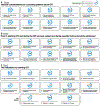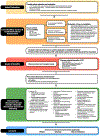Preparing Patients for Oral Immunotherapy (PPOINT): International Delphi consensus for procedural preparation and consent
- PMID: 38597862
- PMCID: PMC11461787
- DOI: 10.1016/j.jaci.2024.02.019
Preparing Patients for Oral Immunotherapy (PPOINT): International Delphi consensus for procedural preparation and consent
Abstract
Background: Despite the promise of oral immunotherapy (OIT) to treat food allergies, this procedure is associated with potential risk. There is no current agreement about what elements should be included in the preparatory or consent process.
Objective: We developed consensus recommendations about the OIT process considerations and patient-specific factors that should be addressed before initiating OIT and developed a consensus OIT consent process and information form.
Methods: We convened a 36-member Preparing Patients for Oral Immunotherapy (PPOINT) panel of allergy experts to develop a consensus OIT patient preparation, informed consent process, and framework form. Consensus for themes and statements was reached using Delphi methodology, and the consent information form was developed.
Results: The expert panel reached consensus for 4 themes and 103 statements specific to OIT preparatory procedures, of which 76 statements reached consensus for inclusion specific to the following themes: general considerations for counseling patients about OIT; patient- and family-specific factors that should be addressed before initiating OIT and during OIT; indications for initiating OIT; and potential contraindications and precautions for OIT. The panel reached consensus on 9 OIT consent form themes: benefits, risks, outcomes, alternatives, risk mitigation, difficulties/challenges, discontinuation, office policies, and long-term management. From these themes, 219 statements were proposed, of which 189 reached consensus, and 71 were included on the consent information form.
Conclusion: We developed consensus recommendations to prepare and counsel patients for safe and effective OIT in clinical practice with evidence-based risk mitigation. Adoption of these recommendations may help standardize clinical care and improve patient outcomes and quality of life.
Keywords: Allergy; Delphi; anaphylaxis; consent; food allergy; oral immunotherapy; patient preparation; risk mitigation; shared decision making.
Copyright © 2024 The Authors. Published by Elsevier Inc. All rights reserved.
Conflict of interest statement
D. P. Mack has provided consultation and speaker services for DBV Technologies (DBV), ALK-Abelló, and Alladapt; and is an investigator for DBV and ALK-Abelló. P. J. Turner reports grants from UK Medical Research Council, NIHR/Imperial BRC, and J. M. Charitable Foundation; and personal fees from UK Food Standards Agency, Aimmune Therapeutics, Allergenis, and Aquestive Therapeutics outside the submitted work. R. L. Wasserman has provided consultation and advisory board services to Aimmune. M. A. Hanna is an investigator for DBV and ALK-Abelló. M. Shaker has participated in research funded by DBV; is an associate editor for
Figures






References
-
- Clarke AE, Elliott SJ, St Pierre Y, Soller L, La Vieille S, Ben-Shoshan M. Temporal trends in prevalence of food allergy in Canada. J Allergy Clin Immunol Pract 2020;8:1428–30.e5. - PubMed
-
- Wasserman RL, Factor J, Windom HH, Abrams EM, Begin P, Chan ES, et al.. An approach to the office-based practice of food oral immunotherapy. J Allergy Clin Immunol Pract 2021;9:1826–38.e8. - PubMed
-
- PALISADE Group of Clinical Investigators, Vickery BP, Vereda A, Casale TB, Beyer K, du Toit G, et al.. AR101 oral immunotherapy for peanut allergy. N Engl J Med 2018;379:1991–2001. - PubMed
MeSH terms
Grants and funding
LinkOut - more resources
Full Text Sources
Medical

